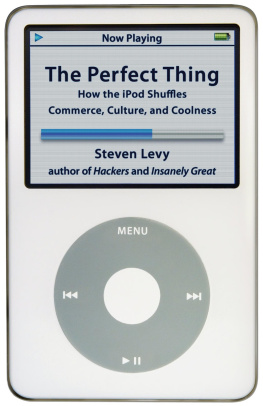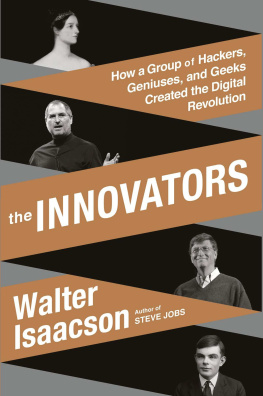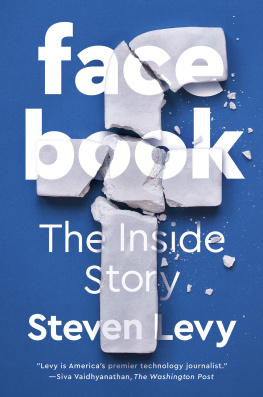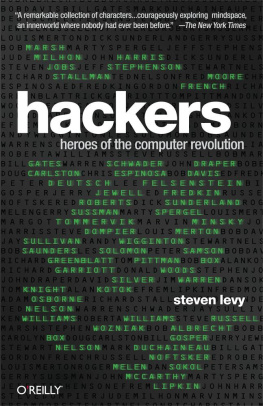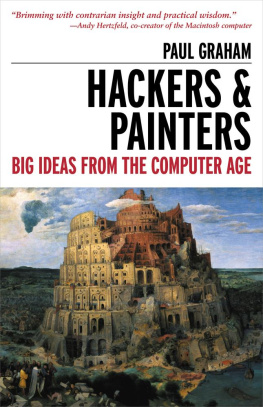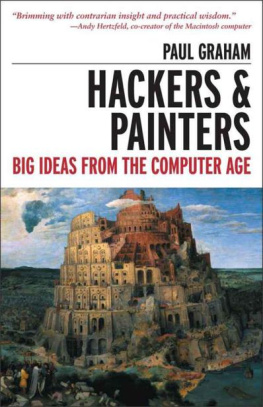I was first drawn to writing about hackersthose computer programmers and designers who regard computing as the most important thing in the worldbecause they were such fascinating people. Though some in the field used the term hacker as a form of derision, implying that hackers were either nerdy social outcasts or unprofessional programmers who wrote dirty, nonstandard computer code, I found them quite different. Beneath their often unimposing exteriors, they were adventurers, visionaries, risk-takers, artists . . . and the ones who most clearly saw why the computer was a truly revolutionary tool. Among themselves, they knew how far one could go by immersion into the deep concentration of the hacking mind-set: one could go infinitely far. I came to understand why true hackers consider the term an appellation of honor rather than a pejorative.
As I talked to these digital explorers, ranging from those who tamed multimillion-dollar machines in the 1950s to contemporary young wizards who mastered computers in their suburban bedrooms, I found a common element, a common philosophy that seemed tied to the elegantly flowing logic of the computer itself. It was a philosophy of sharing, openness, decentralization, and getting your hands on machines at any cost to improve the machines and to improve the world. This Hacker Ethic is their gift to us: something with value even to those of us with no interest at all in computers.
It is an ethic seldom codified but embodied instead in the behavior of hackers themselves. I would like to introduce you to these people who not only saw, but lived the magic in the computer and worked to liberate the magic so it could benefit us all. These people include the true hackers of the MIT artificial intelligence lab in the fifties and sixties; the populist, less sequestered hardware hackers in California in the seventies; and the young game hackers who made their mark in the personal computer of the eighties.
This is in no way a formal history of the computer era, or of the particular arenas I focus upon. Indeed, many of the people you will meet here are not the most famous names (certainly not the most wealthy) in the annals of computing. Instead, these are the backroom geniuses who understood the machine at its most profound levels and presented us with a new kind of lifestyle and a new kind of hero.
Hackers like Richard Greenblatt, Bill Gosper, Lee Felsenstein, and John Harris are the spirit and soul of computing itself. I believe their storytheir vision, their intimacy with the machine itself, their experiences inside their peculiar world, and their sometimes dramatic, sometimes absurd interfaces with the outside worldis the real story of the computer revolution.
Whos Who: The Wizards and Their Machines
Bob Albrecht . Founder of Peoples Computer Company who took visceral pleasure in exposing youngsters to computers.
Altair 8800 . The pioneering microcomputer that galvanized hardware hackers. Building this kit made you learn hacking. Then you tried to figure out what to do with it.
Apple II . Steve Wozniaks friendly, flaky, good-looking computer, wildly successful and the spark and soul of a thriving industry.
Atari 800 . This home computer gave great graphics to game hackers like John Harris, though the company that made it was loath to tell you how it worked.
Bob and Carolyn Box . World-record-holding gold prospectors turned software stars, working for Sierra On-Line.
Doug Carlston . Corporate lawyer who chucked it all to form the Brderbund software company.
Bob Davis . Left a job in a liquor store to become the bestselling author of the Sierra On-Line computer game Ulysses and the Golden Fleece . Success was his downfall.
Peter Deutsch . Bad in sports, brilliant at math, Peter was still in short pants when he stumbled on the TX-0 at MITand hacked it along with the masters.
Steve Dompier . Homebrew member who first made Altair sing, and later wrote the Target game on the Sol, which entranced Tom Snyder.
John Draper . The notorious Captain Crunch who fearlessly explored phone systems, was jailed, and later hacked microcomputers. Cigarettes made him violent.
Mark Duchaineau . The young Dungeonmaster who copy-protected On-Lines disks at his whim.
Chris Espinosa . Fourteen-year-old follower of Steve Wozniak and early Apple employee.
Lee Felsenstein . Former military editor of the Berkeley Barb and hero of an imaginary science-fiction novel, he designed computers with a junkyard approach and was a central figure in Bay Area hardware hacking in the seventies.
Ed Fredkin . Gentle founder of Information International, he thought himself the worlds greatest programmer until he met Stew Nelson. Father figure to hackers.
Gordon French . Silver-haired hardware hacker whose garage held not cars but his homebrewed Chicken Hawk computer, then held the first Homebrew Computer Club meeting.
Richard Garriott . Astronauts son who, as Lord British, created the Ultima world on computer disks.
Bill Gates . Cocky wizard and Harvard dropout who wrote Altair BASIC, and complained when hackers copied it.
Bill Gosper . Horowitz of computer keyboards, master math and LIFE hacker at MIT AI lab, guru of the Hacker Ethic, and student of Chinese restaurant menus.
Richard Greenblatt . Single-minded, unkempt, prolific, and canonical MIT hacker who went into night phase so often that he zorched his academic career. The hackers hacker.
John Harris . The young Atari 800 game hacker who became Sierra On-Lines star programmer, but yearned for female companionship.
IBM PC . IBMs entry into the personal computer market, which amazingly included a bit of the Hacker Ethic and took over.
IBM 704 . IBM was The Enemy and this was its machine, the Hulking Giant computer in MITs Building 26. Later modified into the IBM 709, then the IBM 7090. Batch-processed and intolerable.
Jerry Jewell . Vietnam vet turned programmer who founded Sirius Software.
Steven Jobs . Visionary, beaded, nonhacking youngster who took Wozniaks Apple II, made lots of deals, and formed a company that would make a billion dollars.



